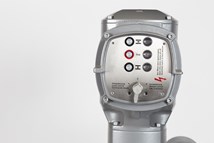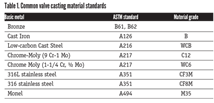The Evolution of Control Valve Diagnostics
How much can you do with 3.6 mA of power?
A Bit of History
Before the 1980s, all valve diagnostic methods were manual. Technicians used mechanical measuring tools, calipers, pressure gauges and the like. Documentation was manual and generally the methods relied tremendously on technician experience. There was no capability to remotely diagnose the health of a control valve.
Beginning in the 1980s, personal computers (PCs) came onto the scene, so they began to be used to do data acquisition by hooking up to the valve. That was the first venture into automatically gathering data from a control valve. Through this, it was possible to see what a valve was doing, its health and how well it was operating. This was adopted first in the nuclear power industry because of the high demand for accuracy.
Mostly it was control valve manufacturers providing this service. Their technicians would go into a plant during a turnaround, which was the only time the valves could be exercised. Time was of the essence, and everything was scheduled considering how much time it took to take the diagnostics, how much to set it all up and put it all back. While this was an improvement over the manual measurements, there still was no remote monitoring, and the use of the PCs and interpreting data from them was also very technician-experience dependent.
As microprocessors began to evolve beyond the PC, digital valve positioners were introduced in 1994. Hughes noted this technology got off to a rocky start because everything was proprietary, so it was difficult for communication to occur between systems to get diagnostics. Problems led to the need for a standardized protocol.
That led to HART (highly addressable remote transducer). According to Hughes, the idea behind this was that existing 420 mAmp command signals could be used and a digital signature could be superimposed over top of that. It was based on Bell Lab’s 202 standard (which came from caller ID). Limitations in HART led to the development of Foundation Fieldbus. It took a decade to agree on what the all-digital protocols would be, and they evolved throughout the 1990s.
From 2000 on, Foundation Fieldbus became the standard for new plants, and HART I/O was used for plants integrating valve information with the digital control systems. Plant asset management (PAM) software integration became more widespread and is now pretty much standard.
Online diagnostics software was introduced to validate performance and health while it was in service. This made diagnostics much more independent of technician experience in addition to being more consistent. The software can be programmed to determine what the best technician could ___from the indicators and give possible corrective action including even what spare parts might be needed.
Industry Standards
Eventually it became apparent there was a need for industry standards.
The HART protocol became the de facto standard in the older analog and hybrid worlds in which installed instruments and valve positioners take the info from the field and send it back. In newer applications, the foundation fieldbus all-digital network provides different information and extensive data can be retrieved from all the different field devices.
There was much effort from 2003 to 2010 into putting manufacturers’ software within some major distributed control systems (DCS) companies. But they were all proprietary, so every time DCS software would change, valve manufacturers would have to test the changes in their systems. It was a huge challenge for an individual valve manufacturer to make sure their software and diagnostics would work on the platform of the big control system company that a user was using. As a result, two standardized systems emerged.
One was the FDT Group, which has full graphics and enjoyed widespread acceptance by end users. Another, EDDL, has limited graphics and limited acceptance.
Valve performance guidelines were set out in ISA 75.13, which defines performance criteria. It was a good start, but because there were so many permutations of valves with actuators, it was difficult to set the standard. ISA SP 75.26 gave guidelines for what should be done in a diagnostic test.
Diagnostic Condition Reporting
In the 1990s there were many ideas regarding what a digital positioner could or should do and what was needed from it. But power was limited to 4 mAmps, so the systems had to be designed to analyze what was most important for the application: diagnostics or performance? It is not possible to have both when power is limited.
However, micro-processors developed very rapidly, going from 8 bit to 16 bit to 32 bit in a very short time, so much more could be done. Manufacturers could focus on better performance algorithms and add diagnostic and pneumatic pressure sensors. Valve position sensors started off with potentiometers, but they had a propensity to break, so manufacturers moved to magnetic non-contact sensors. As the valve moves, the orientation of the magnetic field moves, so these sensors could tell how and where it was moving. LED lights or LCD with buttons and menus also came into use, and these also offered increased access and reliability.
However, diagnostic features remained relatively unchanged and the challenges of control valve diagnostics remained. Positioner self monitoring and alarms made it possible to perform tests and have continuous diagnostics, which was helpful, but often yielded an incomplete picture of the root cause. It was non-deterministic.
Offline diagnostic signatures were also valuable, but are only possible when the process was down, and the schedule was often based on maintenance of other equipment. Thus, the value for predictive maintenance just wasn’t there. It was possible to tell if the valve spent a lot of time closed to the seat, but that may or may not be valuable information for a particular application.
Finally, online diagnostic monitoring became possible. It requires only a minimum valve movement to be relevant and relies heavily on control system integration via HART I/O or FF. The advantages include continuous diagnostics; it is the first line of defense in a tiered diagnostic strategy. It is also good for trending the valve operating environment.
Online diagnostics provide a much better, continuous analysis. The positioner can tell you what’s going on, so you can perform online diagnostics for real-time trending. You can monitor as often as you want and when. It can be initiated on a scheduled basis or be condition-based monitoring, in real time. Valve problems can be isolated from control loop performance or a predictive maintenance management program can be implemented.
Cloud-based storage of valve data makes it possible to have all the information on the bill of materials (BOM), and maintenance and repair history so it’s possible to determine if the valve really is healthy. It is possible to have more and more easily accessible data, including the complete valve life cycle.
It’s becoming so advanced now that a technician can wear a smart helmet that allows him to talk with somebody at the factory or another subject-matter expert. That expert can consult with him on that control valve, because that distant person can see what the technician sees through video cameras also on the helmet. This is going through testing now to make sure it is effective.
With all this remote monitoring, cyber security becomes an issue, so safeguards must be built in. One safeguard makes it impossible to move or change the valve from a remote monitoring location.
In Summary
Online valve diagnostics make it possible for plant maintenance or contract service personnel to make informed, proactive valve maintenance decisions. It has been a dynamic situation so far and will continue to develop into the 2020s.
This feature is based on a presentation given at VMA’s 2018 Valve Industry Knowledge Forum by Leo Hughes, training and development manager at Baker Hughes, a GE Company.
Kate Kunkel is senior editor of VALVE Magazine.
RELATED CONTENT
-
Back to Basics: Globe Valves
There are many applications where the globe valve outshines other designs, so the future is still bright for these long-time favorites of the flow control industry.
-
Valve Selection for Bypass of Control Valves: A Case Study
A bypass line including a bypass valve is typically installed to provide continuous operation in case of regular maintenance of a control valve.
-
Effective Check Valve Selection and Placement for Industrial Piping Systems
When planning a check valve installation, the primary goal is to achieve a valve and piping system that offers the longest service life at the lowest cost.







 Unloading large gate valve.jpg;maxWidth=214)


